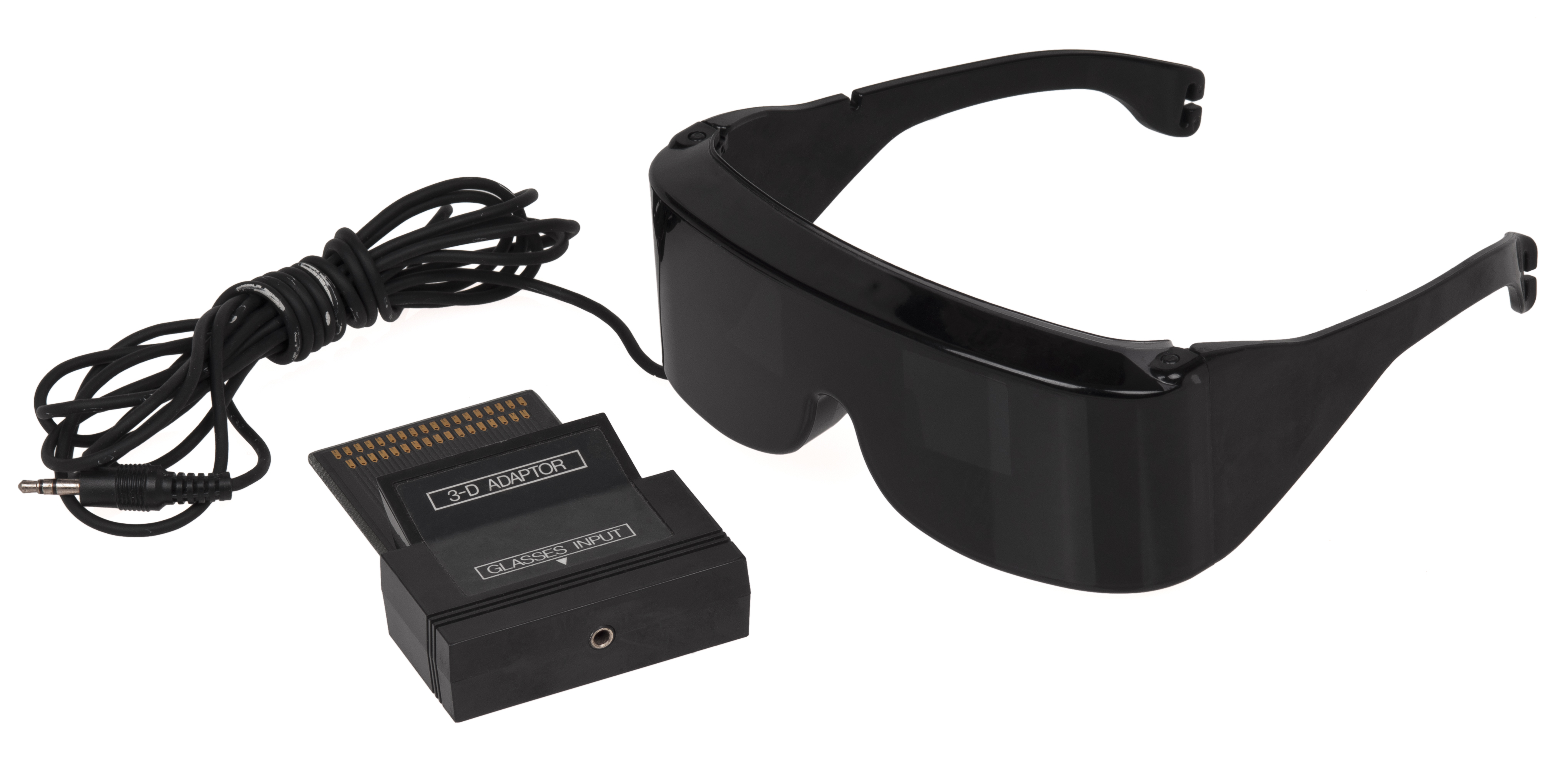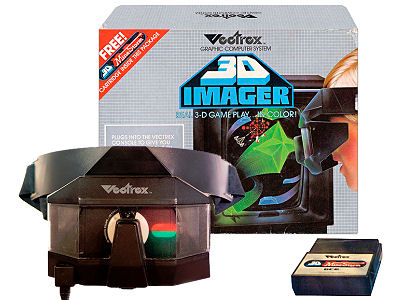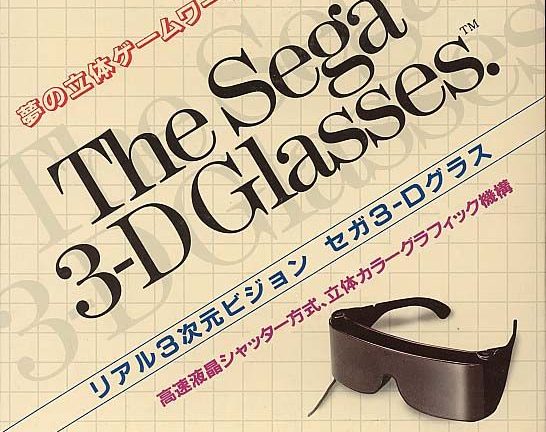
DEVELOPER: Sega
COMPATIBLE WITH: Master System Model 1, Genesis Model 1 with Power Base Convertor
RELEASE DATE: 10/1987 – (EU), 11/07/87 – (JP), 1987 – (US)
3D comes and goes as a fad in movies every thirty years or so (we love you “House of Wax,” “Jaws 3-D,” and “Avatar”), but games have continuously experimented with 3D starting as far back as Milton Bradley’s console, Vectrex. Released in 1982, the Vectrex was a dud of a home console, an expensive vector-based system (with its own monitor!) that died a little over a year after its release. During that time, though, Vectrex released the 3D Imager, a bulky pair of plastic goggles that corresponded with the plastic screen overlays. The 3D would only work with the three 3D-specific games, and required a partially-black, partially-colored disk to be inserted into the goggles themselves. Once the game was turned on and the goggles plugged in with the disk, the disk spun via a motor, producing – in theory – 3D images. Of course, early 80s technology could only reproduce 3D so well (read: not well at all), but the idea was novel, and undoubtedly, very expensive.

Three years after the Vectrex’s passing, an ambitious company named Sega tried establishing a three-dimensional claim for themselves with the Sega 3D Glasses. Rather than using Viewmaster technology to power the extra dimension, Sega used LCD shutter technology, which enabled both the left and right lens of the glasses to shutter back and forth rapidly. This quick movement created a 3D effect, of sorts, and powered a number of 3D-only games like Zaxxon 3D, Space Harrier 3D, and OutRun 3D, among others. And unlike the Vectrex which limited your 3D vision to one eye, SegaScope allowed you to see the games with both your eyes.
But, like squeezing blood from a turnip, trying to replicate 3D from a fuzzy two-dimensional screen is never without its problems. Once the 3D is turned on for any 3D compatible Master System game, the frame rate immediately drops by half. This turns already slow arcade ports like Space Harrier into home-brewed molasses and causes what looks like flicker to splash across the screen. The glasses have been known to work on LCD televisions, but you’ll have to turn off all the image enhancement and correction options. To avoid the hassle, find an old CRT, hook it up, and embrace the reality of yesterday, today.
![Space Harrier 3D (UE) [!]000](https://segadoes.com/wp-content/uploads/2015/02/space-harrier-3d-ue-000.jpg?w=300)
From my perspective, however, all this information is hearsay. I’ve ordered a pair of 3D glasses to use on some upcoming reviews (*peers ahead towards Zaxxon 3D*), but I haven’t received them yet, nor have I ever tried a pair before. I’ve heard from several different sources that the glasses are extremely uncomfortable if you don’t have a small child-sized head and that they have the tendency to break easily. Also – and this doesn’t surprise me in the least – the 3D on them is supposedly less than stellar. Well, of course! Think about this: if Sega’s glasses had produced realistic 3D, they would have been the blockbuster talk of the playground. They could have turned the 8-bit console war, such as it was, in Sega’s favor. Instead, the 3D Glasses had a decent run with a handful of games, disappeared from the public consciousness for a couple decades, and now they sell for unreasonable amounts on eBay. Such is the nature of old peripherals.
3D Glasses PRO TIPS:
- Want to play 3D Master System games, but don’t want to drop a Benjamin on some potentially broken, but COMPLETE RARE IN BOX official 3D glasses? Browse Amazon’s third-party home theater 3D LCD shutter glasses. They use similar tech to Sega’s 3D glasses, but cost a fraction of the price. Be forewarned: there’s a good chance not all of them will work. Do your research and practice safe shopping.
- Are you the proud owner of a Master System II? Congratulations! Those suckers are rare. They also are unable to use the 3D glasses, due to the lack of adapter port on the front of the console. The 3D glasses can work with a Model 1 Genesis and the Power Base Convertor, but not on any other Genesis models.
*cheers to the ELA Fountain for the Featured Image!


11 replies on “Sega 3D Glasses (Master System, 1987)”
The active 3D actually was pretty good. It’s the same technology Sony uses now. Except shutter is synced with a wire instead of wirelessly. Some of the games looked really good like missile defense 3D. And maze hunter 3D. The already low frame rate Space Harrier 3D did not.
I’m excited to try them out. I’ll update the article with my experiences accordingly.
Dylan, you make some good points and probably give the 3-D glasses more credit than any of my friends back in the day did. I loved the few games I had way back then. Maze Hunter was obviously more user friendly than Space Harrier 3D, but I think overall most of the 3D games Sega released were fun for short bursts, nothing more. I still have my 3D glasses, but they seemed to stutter badly the last time I pulled them out, so fond memories is all I have of those games. I also wondered why Sega never tried to start another series (with better glasses) during the Genesis years.
This isn’t 3D, but Sega made a VR headset for arcades in the early 90s and they planned to bring it to home consoles. Apparently it was cancelled, though. Probably for the best.
http://en.wikipedia.org/wiki/Sega_VR
I think Sega’s glasses got a lot of grief for two reasons; firstly 3D technology is hit and miss even today so back in the 80s with an 8-Bit console we cant expect too much. Secondly, compared to the NES the SMS had only a few accessories so it attracted more attention/ridicule. The NES accessories list, from what I understand from AVGN, was immense and a lot of it didn’t work and so by the same token a lot of it fell in to obscurity.
I appreciate that Sega had the balls to experiment with 3D (though for what it’s worth, so did Nintendo with the Famicom), but I often wonder why companies do what they do when the technology is only half there.
Thanks for the comment, Tony.
Sega was a brave company. We’ve talked a few times about how adventurous they were and I think that was the correct thing to in the face of the NES’ superiority in terms of popularity and sales. Its no good being as good as the NES they had to do better to keep the sales up. We could argue for hours which was the better console and honestly it comes down to personnel preference. Both had their advantages and both had their great games that the other didn’t.
But here’s an interesting point. Coming back to Sega’s recent news over abandoning console games; do you think Sega lost the battle to keep producing consoles because the Saturn and Dreamcast started to play it a little safer?
Sega lost whatever goodwill they had received from the Genesis, thanks to the Sega CD, 32X and then the Saturn – all being $200 or more and all being released within 3 years of each other. They got greedy. The Dreamcast was them trying to make things right with the public, but by then, it was too late.
I suppose that sums up Sega’s story right from the days of the SMS – great software and games but let down by their lack of understanding of the people who are their market.
It’s telling how desperate Sega (or, more accurately, Tonka) was that they’d release the Master System’s 3D glasses when Nintendo firmly left theirs in Japan, and never released any of the games for the accessory except Rad Racer (which was altered to use the old red/blue 3D method that is far worse). I’m curious to see if you have any problems with certain games, because back when I had a CRT TV and the Famicom glasses, I could never correctly see the 3D in Konami’s Falsion, despite having no issues with the other 3D System games I owned.
Well, I got the glasses. Now I’m just waiting on the games. Time will tell!